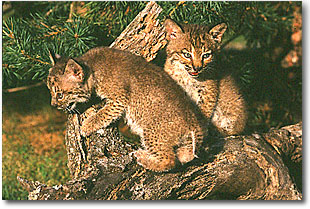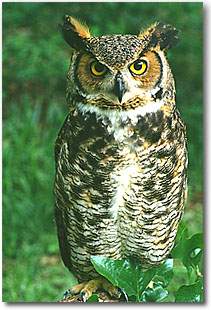|
|

All rights reserved. "Get on over here and bring your camera," she said. " I just had two baby bobcats come in that are so cute you can't stand it". It was my new friend Annette calling. Annette King is a local wildlife rehabilitor and a call such as that is music to a wildlife photographer's ears. Seldom do photographers get a chance for portraits of wild animals with the exception of zoos or game farms but photo opportunities while working with wildlife rehabilitators can be extremely rewarding.
Caring for these animals is a hard, long, dirty, and demanding business. Imagine feeding a dozen or more different animals a day, each with their own diet and needs. Cages must be cleaned, medicines administered, and often, physical therapy given. Free time? Not much. Vacations? Forget it. How can you ask your neighbor to drop by and feed a small zoo while you take off for the Bahamas? Expenses with such an endeavor can put a huge financial strain on the family budget. The cost of food alone can reach staggering proportions, depending of course on the type of animals. Many rehabbers depend on donations from friends, relatives, and the general public. They occasionally get help from the local grocers or restaurants but specialized diets are seldom free. Making Contact Contacting a rehabber for a photo shoot is an exercise in diplomacy. Begin with the Wildlife Rehabilitation Information Directory on the Internet at www.tc.umn.edu/~devo0028. This very informative site not only details the goals of the rehabilitator and what to do when an injured animal is found; but most importantly for photographers, a complete state-by-state listing of rehab facilities. How receptive would you be to a complete stranger who calls asking to come to your home, use your valuable time, and take photos? Somewhat reluctant? Another method, and much more productive, is to write the rehabber, explain who you are and what your qualifications may be. Include a business card and use stationary with your letterhead. If your work has been published, tell them about it and attach some samples. Explain that you will follow up in a few days with a phone call. Some will be flattered that you want to photograph their "babies"; others will decline. If unsuccessful with the private sector, check with your state's park department. Some have their own rehab facilities. My home state of Oklahoma has two; Three Forks Nature Center at Sequoyah State Park and one at Beaver's Bend State Park. Once you get an invitation, explain that you would like your appointment to be in the early morning or late evening, if possible, to make use of the best light. If this is not convenient for them, go with whenever they have time for you. It may work out that you can return under more favorable photographic conditions.
The Photo Challenge To make a fine image of a rehab animal often requires a healthy dose of imagination, versatility, and preparation. It's quite doubtful the grounds of a rehab facility will have the look of a natural habitat, so consider bringing your own props. If, for instance, your subject is a bird of prey and can be moved outside the cage, try using an old tree limb securely mounted in a Christmas tree stand, bolted to a wide piece of plywood. In this manner, you can position the perch in the best spot for lighting and background. Make sure the perch is solid. The bird will not sit long, if at all, on a shaky limb. Many of the birds will have an injured wing, which can possibly be hidden by shooting from its "good" side. If the bird is tethered, a well-placed branch of leaves or pine needles can hide the restraints. Remember to move slowly. Any animal will be uncomfortable with a stranger doing uncommon activities within its circle of fear. By all means, do not ask to use a bird whose injury is still mending. You will receive an emphatic "NO" from the rehabber.
Most birds will have a favorite perch and you may be able to set up your own background while the subject is eyeing you from another part of the cage. In the past, I have used a large piece of black velvet attaching it to the wire and directly behind the perch using safety pins or clamps. The velvet helps to reduce spectral highlights. While not exactly a natural look, it's definitely an improvement over plywood. It may be some time before the bird returns after someone has redecorated its living room but be patient. A bit of strategically placed food can speed up the process. If there's no way to enter a cage, there are still ways of making acceptable images. By using a telephoto lens and placing the front element as close as possible to the wires, they become invisible to the camera if in the absence of a strong, reflecting light. Occasionally, you get lucky. One injured eagle would not tolerate anyone in its cage so after checking the position of the sun, I could see that it would soon cast light on only a small portion of the enclosure. By having the rehabber place some food in the shaft of light, the eagle was visually isolated from its surrounding using a 300mm lens. A close head and shoulders shot gave no hint as to where the photograph had been taken. Some unwanted background will undoubtedly find its way into a few of your compositions but with the aid of a good image-editing program, such as Photoshop, your computer can clean it up rather easily. Entering the cage of a potentially dangerous mammal is another matter entirely. Use a little discretion here. A bobcat that may have been as docile as a house cat with people it sees every day, could become a different animal entirely at the sight of an unfamiliar intruder carrying camera equipment. The assurance of the rehabber that the animal is completely safe is no guarantee that the animal won't panic and exhibit behavior they haven't seen before. So-called "tame" animals can revert back to their natural ways in the blink of an eye under provocation of a perceived threat. So ask yourself, "Is this photo worth the risk?" A safer solution is to have the rehabber use a leash and place the animal, if possible, in a natural setting. Often, a pleasing headshot can be achieved with a little manipulation of fur, as in the case of a wolf, to hide the collar or leash. Perhaps the best opportunities of all come with the arrival of the babies in spring. Whitetail fawns are brought into rehab centers by the dozens. The reasons vary; a car kills the mother doe, the fawn becomes weakened when covered with ticks, or it may have been injured from a dog attack. Many well meaning nature lovers bring in a fawn thinking it has been abandoned, when in reality, it was merely hiding where its mother had left it. Fawns easily adapt to the presence of humans and are simple to photograph. The biggest problem with fawns is keeping them from licking your lens. I was thrilled to get a call that a young red fox had found its way to one of the state agencies. It was quite active and couldn't be removed from its pen. Once again, the background was a problem. Looking around, I spotted a brush pile heaped with trimmed branches covered with autumn leaves. With permission, I constructed a wall of brush on one side of the pen and lured the fox in place with small pieces of food. The fox loved the snacks and all the news things to smell. He was well occupied while I shot several rolls of film. Baby raccoons and opossums are also common residents of a rehab center. Easily handled, they can be placed on logs (you did bring one with you didn't you?) or other natural settings. In most cases, an assistant to keep the little critters in place and out of harms way will be invaluable. Keep in mind that some rehabbers prefer to keep human contact to a minimum. The thinking is that this keeps the animals from bonding or "imprinting" with man, thus making it easier for them to resume a normal life in the wild. Leave a Good Impression Call it gratitude, diplomacy, or possibly an investment but as you leave your shoot, offer the rehabber a token of your appreciation. Often they will be thrilled with a nice print of one of their little darlings. Be a little generous, give a nice matted 8x10 or 11x14 of one or more of your best shots. As a bonus, the photographer will get some free advertisement and maybe a reference or two for future work. As mentioned previously, wildlife rehabbing can be expensive. Offer to make a donation toward buying some food and medicine for the animals or rebuilding an old cage. Leave a good impression and maybe someday you'll get a call similar to this. "Hey, grab your camera. Bring lots of film. You won't believe what just came in." About the images…
WW-NPN 125 Comments on this article? Send them to the editor. |
|
|
 The goal of a rehabber (as they're commonly called) is to care for, nurture, and provide a safe haven for wild animals that have been injured, orphaned, or abandoned with the primary goal of retuning the animal to it's rightful place in the wild. They sacrifice their time, their money, and, in many cases, part of their home in pursuit of their goals. They do NOT take in wild animals as pets.
The goal of a rehabber (as they're commonly called) is to care for, nurture, and provide a safe haven for wild animals that have been injured, orphaned, or abandoned with the primary goal of retuning the animal to it's rightful place in the wild. They sacrifice their time, their money, and, in many cases, part of their home in pursuit of their goals. They do NOT take in wild animals as pets. If the bird must remain in a cage, a whole new set of photographic problems arises. An uncluttered image will seem impossible but there are solutions. If the bird is housed in a large aviary and can be entered, you have even more options. First, just the act of entering the cage may cause the bird to become agitated. Again, be quiet and avoid sudden moves. Allow ample time for the bird to accept your presence before taking any further action. I learned this lesson the hard way when I entered the cage of a young red-tailed hawk too suddenly. It freaked out, flying from side to side in the cage until it decided that my skull was a landing spot and dove in, complete with extended talons. Served me right and I learned a valuable lesson.
If the bird must remain in a cage, a whole new set of photographic problems arises. An uncluttered image will seem impossible but there are solutions. If the bird is housed in a large aviary and can be entered, you have even more options. First, just the act of entering the cage may cause the bird to become agitated. Again, be quiet and avoid sudden moves. Allow ample time for the bird to accept your presence before taking any further action. I learned this lesson the hard way when I entered the cage of a young red-tailed hawk too suddenly. It freaked out, flying from side to side in the cage until it decided that my skull was a landing spot and dove in, complete with extended talons. Served me right and I learned a valuable lesson.